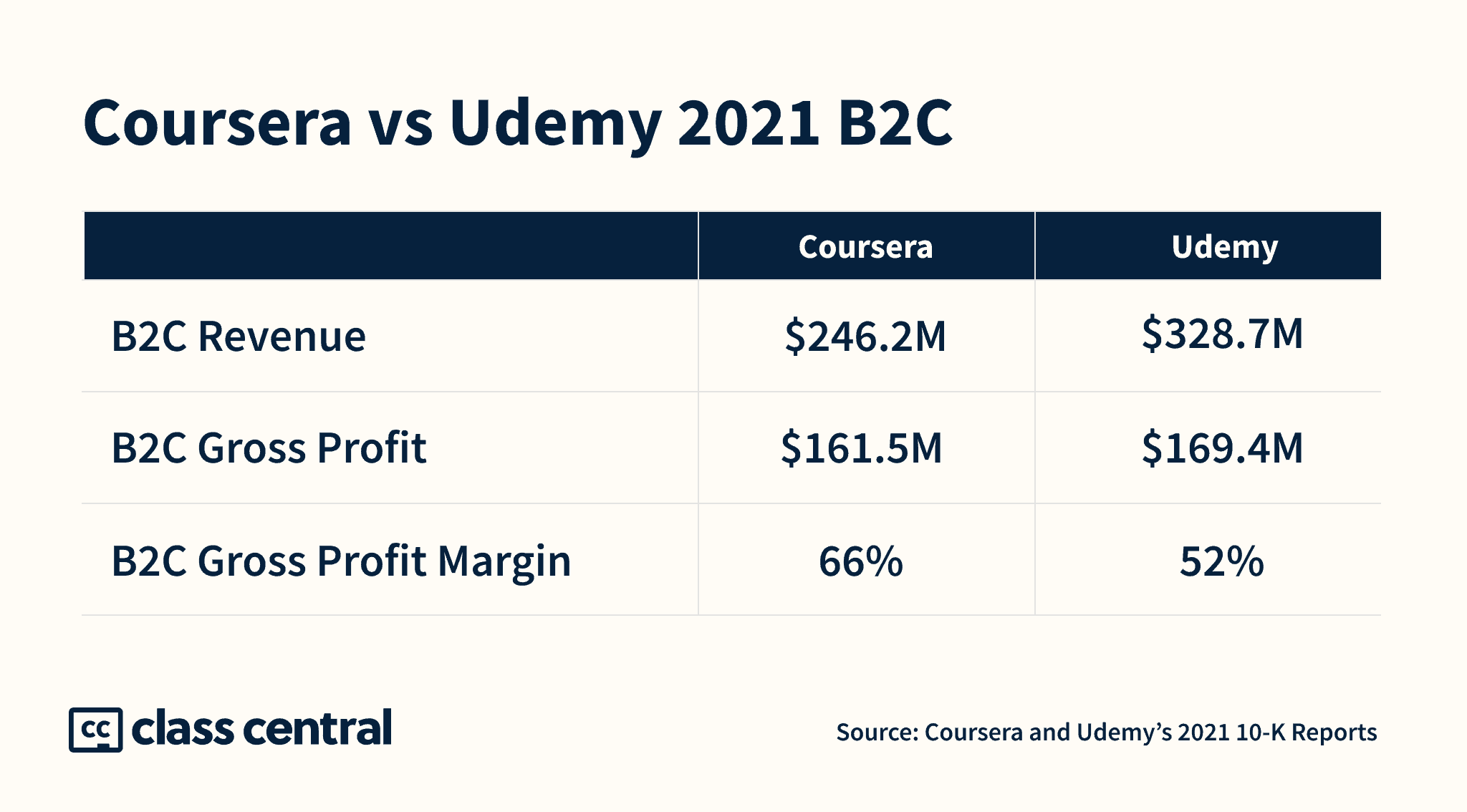Content vs Credential: Coursera Beats Udemy’s B2C Revenue
In the third quarter of 2022, for the very first time, Coursera overtook Udemy in terms of consumer revenue.
In online education, which is more monetizable, content or credentials? Udemy and Coursera’s B2C revenues in 2022 Q3 might give us a hint.
On the surface, Udemy and Coursera are similar: they’re both marketplaces for online courses. Where they mainly differ is on who can offer these courses.
On Udemy, anyone can create a course. On Coursera, only certain universities and organizations can offer courses. In recent times, Coursera has tried to expand its catalog by letting professionals create Guide Projects.
But what they sell is quite different. On Udemy, you pay for the course, while on Coursera, the course is usually free-to-audit, and what you really pay for is the credential or certificate.
Early this month, I reported that for the first time ever, Udemy’s B2B revenue exceeded its B2C revenue. But that wasn’t the only first: in 2022 Q3, Coursera’s B2C revenue eclipsed Udemy’s B2C revenue — Udemy made $74.6 million in B2C, but Coursera made $78 million.
In the B2C segment, Coursera also has better margins than Udemy. This means that they keep a bigger cut of the revenue. In 2021, Coursera’s gross profit margin was 66%, compared to Udemy’s 52%.
So even though Udemy made $80 million more than Coursera in 2021 in the consumer segment, it netted just $8 million more than to Coursera.
Udemy’s best quarter in terms of B2C revenue was 2020 Q3, when the company made $91 million compared to Coursera’s $57.3 million. While Coursera has gained on its pandemic numbers, Udemy has struggled to do that. In 2022, Udemy is on track to see its B2C segment revenue decline. In 2021, Udemy’s B2C segment revenue grew by just 1%.
We know Udemy’s ceiling. Over the next few quarters, we’ll see whether Coursera faces the same obstacles.
But for B2B revenue, the story is completely different.
Udemy vs Coursera in 2022
In April 2022, when I compared Coursera and Udemy’s 2021, Udemy’s market cap ($1.6B) was about half that of Coursera ($3.0B). A few months later, the situation had dramatically changed.
| Coursera | Udemy | |
| Market Cap | $2.06B | $2.6B |
| 2022 Revenue | $524.0M | $629.1M |
| 2022 B2C Revenue | $295.6M | $315.1M |
| 2022 B2B Revenue | $181.3M | $314.0M |
In 2022, Coursera saw its stock price drop by 45%, while Udemy’s dropped by 20%, thus reversing their fortunes. This is probably one of the reasons Coursera conducted layoffs last week.
The biggest drop came when Coursera announced its 2022 Q2 results. The stock dropped by 20%. To understand why this happened, read my report on Why Coursera Stock Dropped.
After the recent publication of its 2022 Q3 report, Coursera’s stock recovered a bit, thereby mitigating some of the decline seen in 2022.
| Coursera | Udemy | |
| Market Cap | $2.54B | $1.57B |
| 2023 (Q1-Q2) Revenue | $301.3M | $354.6M |
| 2023 (Q1-Q2) B2C Revenue | $169.0M | $158.3M |
| 2023 (Q1-Q2) B2B Revenue | $106.4M | $196.8M |










Rupesh Tela
Interesting analysis Dhawal, just a few points worth considering on key differences before the conclusion
Business model and pricing difference: we know Udemy make most of its $ from B2C through single-course selling which is typically low cost and one-time transactions (user mostly gets lifetime access to the content) on the other hand Coursera though do not charge for course audit they charge for certification or as you said credentials. However, the difference is their courses are expensive and also a lot of courses are a part of the specialization which sort of multiple courses in one learning path and typically charges per month based on time commitment. This is more like a short subscription and the user would end up paying until completes the specialization (usually in multiple months). Also, they have other products like Professional Certificates with similar models. Coursera has recently acknowledged that certificates have driven their B2C revenue.
Subscription: As Udemy’s subscription (Udemy Pro) is not available in all the markets and is mainly focused on IT certificates and hence less relevant for a larger audience for learning, on the other hand, Coursera Plus has more appeal due to content relevance to a broader audience and presence in many regions and markets. I believe subscription revenue must have played a key role in B2C revenue for Coursera this year as their takers are increasing.
Marketing focus: I believe Udemy has reduced the marketing spend for B2C in the last couple of quarters and may consider in Q4 with Black Friday and New Year discounting, at least they did in the past.